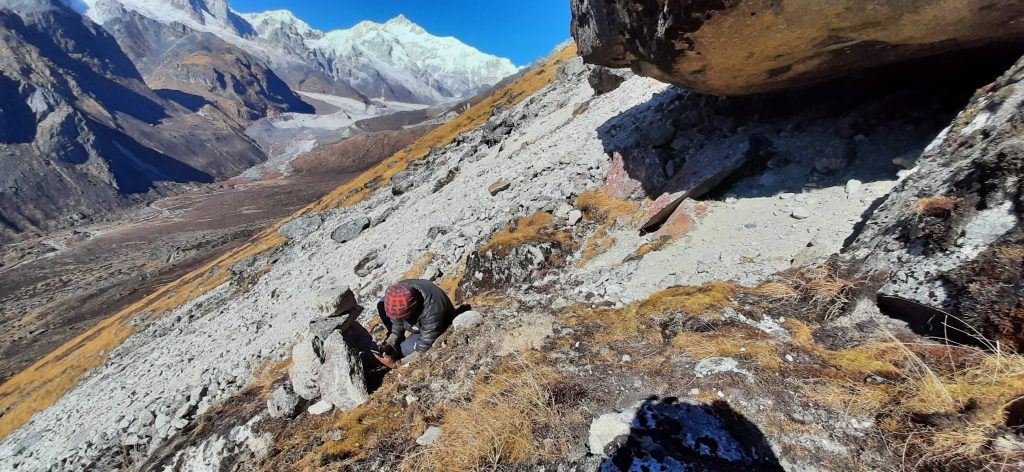The snow leopard is designed to vanish. Thick grey fur, dappled with dark rosettes in a pattern unique to each individual, provides camouflage akin to an invisibility cloak in its rocky habitat. Together with its stealth and remote, high-altitude habitat, this makes it among the most challenging animals to study.
But we need to overcome the difficulties and ramp up research to ensure these majestic animals don’t disappear for good.
That’s the conclusion of a new WWF report reviewing snow leopard research since 1904. Highlighting gaps in knowledge, it identifies research priorities to provide more effective conservation, including the basic details: how many snow leopards survive, and where.
These ‘ghosts of the mountains’ prowl lofty ranges in 12 Asian countries, from the Himalayas in the south to Russia in the north. It’s a vast area, spanning over 1.7 million sq km – of which more than 77% is untouched by snow leopard research of any kind, let alone rigorous surveys.
“Most research has focused on estimating populations and mapping their distribution, yet we have robust figures for less than 3% of the species’ range,” explains Rishi Kumar Sharma, WWF’s global snow leopard programme leader and first author of the new report. “That’s worrying, because a lot of conservation decisions – including big ones, such as IUCN conservation status – are based on such knowledge.”
© WWF-MONGOLIA
guessing game
That deficit is reflected in the vastly different population estimates, which range from 3,920 to 6,930. We’re working with the Global Snow Leopard and Ecosystem Protection Program on a five-year plan to obtain a more accurate estimate. In 2016, Bhutan was the first country to complete a comprehensive snow leopard survey, estimating a population of 96.
And in March 2021, Mongolia published the results of its nationwide survey, a four-year project by the Ministry of Environment and Tourism with the help of partners including WWF. The study, involving more than 500 people, 40 field surveys, 15 collared cats and 1,475 camera traps, estimated 953 adults.
In Nepal – believed to host the fourth-largest snow leopard population, last estimated at 300-400 – we’re supporting the government’s research efforts. In May 2021, two adults were fitted with GPS collars in Shey Phoksundo National Park, bringing Nepal’s tally of collared cats to eight, providing data about territories and movements.

© SERGELEN E / WWF-MONGOLIA
citizen scientists
We’re also building on long-established relationships with mountain communities.
“The survey areas in Nepal are so remote research wouldn’t be possible without local citizen scientists,” explains Nicky Robertson, our senior adviser on Asia programmes. “Having lived here for millennia, they know the landscape like the back of their hands, and can offer valuable insights into snow leopard behaviour. They know where to locate camera traps and where we might stand the best chance of capturing a cat for collaring.”
Similarly, in the Indian state of Sikkim we’re supporting the training of Himal Rakshak mountain guardians to monitor biodiversity. And in China, which is home to around 60% of the world’s snow leopard habitat, we work with communities, including Aksay herdsmen, to set camera traps and collect data.
We’re also collaborating with government authorities and other NGOs in China to develop research programmes in protected areas such as Wolong National Nature Reserve which, though best known for giant panda conservation, is yielding insights into its snow leopard population.
Crucially, the new report highlights that snow leopard research needs to cover aspects other than population and distribution. “To understand where to focus our conservation efforts, we must improve our knowledge of threats and population trends,” explains Becci May, WWF’s expert on Asia’s big cats.
THREATS TO SNOW LEOPARDS

Habitat degradation and loss
People and their livestock live in and near snow leopard habitat, which is also affected by new roads, mines and other economic developments. Climate change will exacerbate these pressures: it’s estimated that by 2070 snow leopard habitats will decline by 8–23% and become increasingly fragmented.

Depletion and loss of prey
Livestock grazing at higher altitudes can lead to a reduction in numbers of the snow leopards’ natural prey species such as blue sheep. Human hunting of species such as argali sheep also reduces the availability of prey.

Conflict with people
Snow leopards sometimes kill domestic livestock, often when the availability of their wild prey has been reduced. Of the estimated 221–450 snow leopards killed by people annually across their range, 55% are targeted by herders in response to livestock predation.

Poaching and illegal trade
Snow leopards have long been hunted for their luxuriant, beautiful fur. Illegal hunting and trade in pelts, as well as other body parts – sometimes for traditional remedies – continues. Snow leopard cubs orphaned by hunters are also captured and sold.
Snow leopards are targeted by poachers, and their habitats are affected by mining, large-scale infrastructure projects, livestock grazing, over-harvesting of cordyceps (‘caterpillar fungus’) and poorly managed tourism. Climate change is another major threat: it’s estimated that by 2070 only 35% of the current snow leopard range will maintain a suitably stable climate. Many of these issues affect people, too.
“When I analysed the data, I realised that 80–85% of snow leopard habitat is outside formal protected areas,” says Rishi, “so local people are dependent on the same ecosystems as the cats. Yet there’s been little research into the human dimensions of conservation.”
That means trying to understand the opportunities from, and threats to, coexistence between people and snow leopards. In Nepal, citizen scientists are helping survey blue sheep, a key snow leopard prey species. If blue sheep numbers decline, perhaps because of intensive grazing by domestic herds, hungry big cats are more likely to prey on livestock.
With your help, we’re exploring practices that reduce overgrazing and improve the habitat for blue sheep. We’re also supporting the construction of predator-proof corrals (pens) to protect livestock overnight, and community-based insurance schemes that provide financial relief to herders who lose animals to snow leopards. Testing methods for reducing conflict helps us better understand what works best where, and how effective these techniques are.
Gallery: Camera trap trek in Sikkim
Because snow leopards live in such inhospitable terrain, camera traps are one of the best methods we have for monitoring their movements. Installing them requires plenty of local knowledge and a head for heights. (Best viewed in landscape orientation on mobile devices.)






© RISHI KUMAR SHARMA
A HOLISTIC APPROACH
In India, our snow leopard strategy focuses on ensuring local people and wildlife alike benefit. “We foster partnerships, supporting communities to become stewards for conservation,” explains Rishi. “Rather than focusing on the needs of one species, we’re exploring how to protect rangelands for the snow leopards’ wild prey and for the communities whose livestock graze those landscapes, and who rely on it for other resources.
“That requires research into the productivity and carrying capacity of the land, and finding solutions to reconcile the needs of people and wildlife. It’s a holistic method that sees snow leopards, people and livestock as one socio-ecological system.”
Thanks to you, we support this work in Sikkim and a new project in Arunachal Pradesh, trialling a fresh approach in the Mago-Chu valley.
“We’ve spent a year listening to communities in Mago-Chu, trying to understand their perspectives on snow leopard conservation, on ecosystems, on their own lives,” says Rishi. “We’re asking: what solutions might they devise? They’ve lived here for generations and represent huge repositories of traditional knowledge that can be blended with modern conservation science to develop more effective interventions.”
If Rishi’s report demonstrates a pressing need for research, it’s also a launchpad for collaborative efforts. By sharing what we’ve learned with partners, we’re continuing to develop the local and international relationships on which our work is built.
“At WWF we’re not interested in merely collaring a few individuals or estimating populations in one landscape,” says Rishi. “We’re focused on finding solutions to complex issues and challenges that have long-term impacts on snow leopard conservation.”
Adopt a snow leopard
To help these majestic big cats survive the challenges they face, you can adopt a snow leopard.
More to explore

The world’s climate change hotspots
Climate change could make critical ecosystems around the globe unsuitable for wildlife or people. Here are some of the stories from the affected areas

